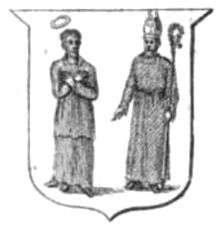Diocese of Ross (Scotland)
Coordinates: 57°34′52″N 4°07′55″W / 57.581°N 4.132°W
 | |
| Head | Bishop of Ross |
|---|---|
| Archdeacon(s) | Archdeacon of Ross |
| Known rural deans | Dingwall, [not known] |
| First attestation | 1127 x 1131 |
| Metropolitan before 1472 | None |
| Metropolitan after 1492 | Archbishop of St Andrews |
| Cathedral | Fortrose Cathedral |
| Previous cathedral(s) | Rosemarkie (?) |
| Dedication | St Peter |
| Native dedication | St Boniface (or Curetán) |
| Canons | Secular |
| Mensal churches | Nigg, Tarbat |
| Common churches | Applecross, Gairloch, Kintail, Lochalsh, Lochbroom, Lochcarron |
| Prebendal churches | Alness, Ardersier (Dean), Avoch (Abbot of Kinloss), Contin, Cullicudden, Dingwall, Edderton (Subdean), Fodderty (archdeacon), Inverferan (Succentor), Kilchrist, Killearnan (Archdeacon), Kilmorack (Precentor), for a brief time held by the Chancellor), Kilmuir Easter, Kilmuir Wester (Dean), Kiltearn, Kincardine, Kinnettes (Chancellor, held briefly by Precentor), Kirkmichael, Lemlair (briefly held by Archdeacon), Logie Easter, Logie Wester (Treasurer, briefly held by Archdeacon), Newnakle, Nigg (Bishop), Rosemarkie, Roskeen, Suddy (Precentor), Tain (Subdean), Tarbat (Bishop), Urquhart (Treasurer), Urray (Succentor) |
| Catholic successor | Merged into resurrected Diocese of Aberdeen, 4 March 1878 |
| Episcopal successor | Diocese of Moray, Ross and Caithness |
The Diocese of Ross was an ecclesiastical territory or diocese in Scotland in the Middle Ages and Early Modern period. The Diocese was led by the Bishop of Ross, and was based at Fortrose. The diocese had only one Archdeacon, the Archdeacon of Ross, first attested in 1223 with the appearance of Archdeacon Robert. There is only one known rural dean, the rural dean of Dingwall, though there were almost certainly more.
A dean of the cathedral chapter is first attested in 1212 x 1213; a Subdean in 1256. A Precentor (also called Chanter) is attested in 1255, a Succentor in 1256. A Chancellor is attested for the first time in 1212 x 1213, a Treasurer in 1227.
Following the Scottish Reformation of 1560, the Presbyterian Church of Scotland abolished the episcopacy in the diocese. The Roman Catholic Church continued to appoint bishops in communion with the Holy See. Bishop John Lesley, however, was a post-reformation bishop who remained catholic. Episcopacy was abolished in the Church of Scotland between 1638 and 1661, when it was restored under the "Restoration Episcopate". After the Glorious Revolution of 1688, Scottish bishoprics again came under threat until in 1689 Episcopacy was permanently abolished in the established church in Scotland. From the early 18th century, the Scottish Episcopal Church appointed bishops.
In the twelfth century, the diocese is usually called "Rosemarkie", but thereafter it is called Ross. The diocese covered, roughly, the old county of Ross (also called Ross-shire).
List of parishes
- Alness
- Altyre (now Kilmorack)
- Applecross
- Ardersier [detached, Moray]
- Avoch
- Contin
- Cromarty
- Cullicudden
- Dingwall
- Edderton
- Eddyrdor (now Killearnan)
- Fodderty
- Fortrose Cathedral
- Gairloch
- Inveraferan (now Urray)
- Kilmoremethet (now Kilmuir Easter)
- Kilmuir Wester
- Kiltearn
- Kintail
- Kincardine
- Kinnettes
- Kirkmichael
- Lemlair
- Lochalsh
- Lochbroom
- Lochcarron
- Logiebride (now Logie Wester)
- Logiemethet (now Logie Easter)
- Nevoth (or Newnakle; now Nonakiln)
- Nigg
- Rosemarkie
- Rosskeen
- Suddie
- Tain
- Tarbat
- Tarradale (now Kilchrist)
- Urquhart
Titular Catholic see Rosemarkie
In 1973, it was nominally restored as a Catholic Titular see of the lowest (Episcopal ) rank, under the name Rosemarkie. It has had three incumbents
Bibliography
- Cowan, Ian B., The Parishes of Medieval Scotland, Scottish Records Society Vol. 93, (Edinburgh, 1967)
- McNeill, Peter G.B. & MacQueen, Hector L. (eds), Atlas of Scottish History to 1707, (Edinburgh, 1996)
- Watt, D.E.R., Fasti Ecclesiae Scotinanae Medii Aevi ad annum 1638, 2nd Draft, (St Andrews, 1969)
.png)